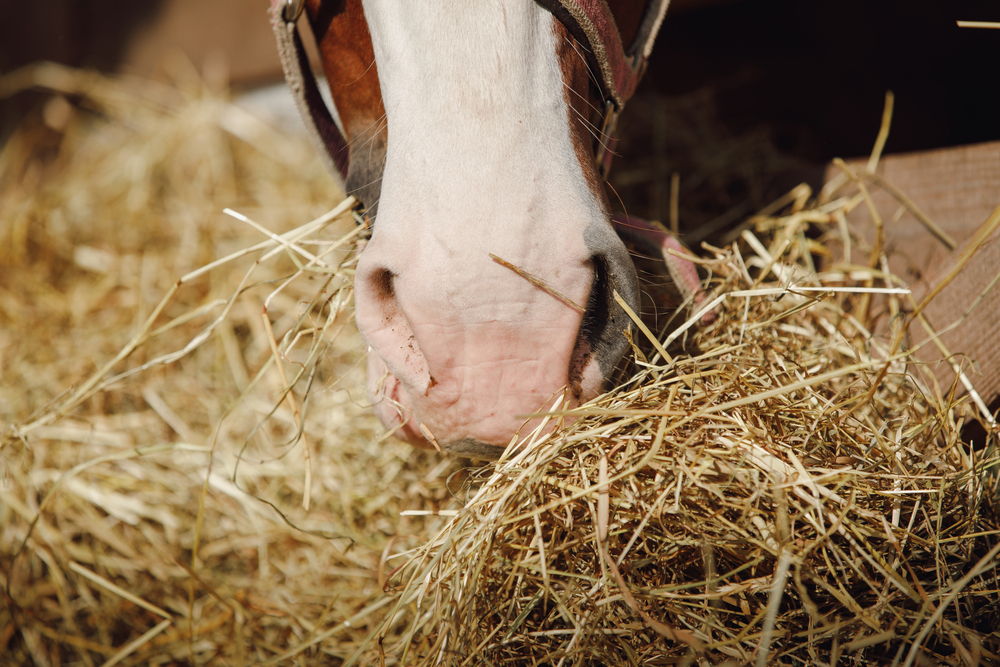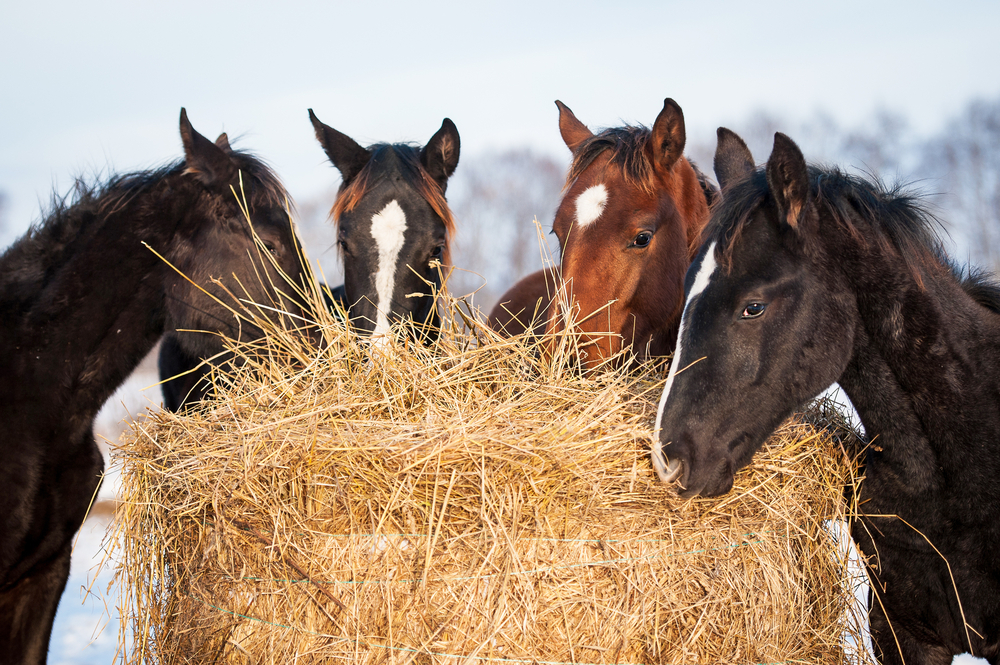- Your source for stall mats, rubber arena footing, arena harrows and arena dust control.

Horse people have very divisive opinions on almost everything to do with horses. They’ll argue on what’s best for performance or behavior. But some foods are not up for debate, as they can hurt or kill a horse, even types of hay. So if you own a horse, you need to know: what kind of hay is not good for horses?
There are many types of hay and grasses that should not be fed to a horse, including perennial ryegrass, dallisgrass, Argentine bahiagrass, sorghum, switchgrass, foxtail, and even lawn clippings. Also, even the right kinds of hay can kill a horse if it is moldy.
While knowing the names of hay and grasses helps horse owners avoid them at the shop, some varieties grow wild in fields. Also, a horse owner needs to know what to look for when buying hay to check for both quality and lack of dust, weeds, and mold.
10 Types of Hay and Grasses Horses Can’t Eat
We’ve put together a list of 10 hays and grasses horses can’t eat, where they are found, and how they can harm a horse.
| Type of Hay or Grass | Where It Is Found | How It Harms Horses |
Argentine Bahiagrass | Originally from Argentina, this is a popular broadleaf is often found in pastures in the Southern States such as Florida. | The grass produces seeds that can be diseased thanks to ergot, a fungus. It will cause a pregnant mare to abort . . |
Dallisgrass | Dallisgrass originated in Uruguay and Argentina and was named after A.T Dallis, who thought it would be good for pastures in the Southern United States. It is now considered a pervasive weed. | The weed’s seeds are, like Bahiagrass, prone to contracting ergot. This not only can cause pregnant mares to abort but is toxic enough to create neurological symptoms in horses . . |
Foxtail Millet (German Millet) (German Millet) | Foxtail millet is a popular annual fine stem grass. It is water efficient, has a short season, and dries quickly, making it ideal for farming. | Foxtail Millet can cause problems for horses, depending on the quantity and the horse. Potential problems include causing a laxative effect, cystitis, kidney problems, and bone and joint problems. causing a laxative effect, cystitis, kidney problems, and bone and joint problems.The chemical glucoside setaria is also found in foxtail and can cause illness or death. Foxtail Millet has also been known to cause oral lesions in horses’ mouths. |
Johnsongrass (Sorghum Halepense) (Sorghum Halepense) | Johnsongrass is a warm-season perennial that can be found on all continents except Antarctica. It is considered an invasive plant in many parts of the world, including the United States. | Johnsongrass can produce cyanogenic glycosides and nitrates that can be lethal to horses. that can be lethal to horses. |
| Lawn Clippings | Anywhere there are lawns. | Lawn clippings lead to choking, stomach problems, be full of pesticides, herbicides, and could contain poisonous weeds mixed in with the grass. lead to choking, stomach problems, be full of pesticides, herbicides, and could contain poisonous weeds mixed in with the grass. |
Meadow Foxtail | Meadow Foxtail is a perennial tufted grass that provides food for invertebrates such as caterpillars and butterflies. | Meadow Foxtail is not recommended for horses as it can cause lesions in the mouth and ulcerations of the tongue, gums, and cheeks, leading to abscesses. is not recommended for horses as it can cause lesions in the mouth and ulcerations of the tongue, gums, and cheeks, leading to abscesses. |
| Moldy Hay | Any hay that is old or has been stored or packaged improperly. Or hay that’s been left lying around too long. | Moldy hay can contain spores that lead to respiratory problems and, sometimes, mycotoxins. that lead to respiratory problems and, sometimes, mycotoxins. |
Rye & Perennial Ryegrass | A perennial used throughout the United States for turf. | Ryegrass can contain endophytes, a tiny fungi, that lead to “ryegrass staggers .” It is a mycotoxin. .” It is a mycotoxin. |
Sudan Grass | A sorghum forage type, its drought-resistant properties make it a popular choice for livestock pasture. | Horses who eat Sudan grass may develop equine cystitis, ataxia syndrome, and cyanide Poisoning. may develop equine cystitis, ataxia syndrome, and cyanide Poisoning. |
Switchgrass | Switchgrass is native to North American and is a dominant prairie tallgrass. | Switchgrass has steroidal saponins, which can damage horses’ livers and cause secondary photosensitization. which can damage horses’ livers and cause secondary photosensitization. |
8 Tips When Buying Hay
Everyone is advised to buy “quality hay” for their horses. But what does that mean? What should a buyer look for when buying hay? We have eight tips for when buying and evaluating hay.
- Hay should smell good. Beware of any that smells musty and metallic
 .
. - Inspect bales for weeds.
- Look out for infestations such as blister beetles
 .
. - Ask for a bale to be opened so you can inspect the insides, as that’s the part that matters most.
- Ask to see where the bales have been stored. Being covered can be good, but not necessarily if they’ve been tightly packed and are not getting air circulation
 .
. - Beware of excessively warm hay bales
 .
. - Beware of hay that is excessively heavy
 .
. - Contrary to popular belief, the color of hay is not an accurate way to evaluate its quality. The only way to truly know a hay’s quality is to have it laboratory tested
 .
.

5 Tips When Feeding Hay
Hay, even good hay, can have some dust in it. Also, some horses are uniquely sensitive to hay spores, even if the content is considered safe. We have five tips on reducing the amount of dust in the hay when feeding a horse.
- Place hay lower than the horse’s head
 to limit the dust and particles inhaled through the horse’s nostrils.
to limit the dust and particles inhaled through the horse’s nostrils. - Store hay separate
 from where horses are stabled.
from where horses are stabled. - Make sure there is proper ventilation
 in the stables.
in the stables. - If hay appears dusty, steam it
 or try soaking it between 5-30 minutes before feeding to minimize respiratory problems. However, do not leave damp hay in a feeder for long periods.
or try soaking it between 5-30 minutes before feeding to minimize respiratory problems. However, do not leave damp hay in a feeder for long periods. - Do not feed any obviously moldy hay and grains.
Pros and Cons to 6 Horse Hays and Grasses
Horse hay generally falls into two categories: legumes and grasses. For example, alfalfa (lucerne) is a legume hay, where oat hay, a cereal grain, is a grass hay. Here are six hays and grasses you can feed your horse and their pros and cons.
| Hay | Pros | Cons |
Alfalfa (Lucerne) (Lucerne) | High in protein, energy, vitamins, and minerals while being easily digestible. | It can provide too many calories for some horses and is prone to blister beetles. Due to alfalfa’s high calcium content, you will need to make sure it balances with the animal’s phosphorus needs. |
Bromegrass | Horses like it, and the protein content is considered high, and the crude-fiber content is low. | It is lower in calcium than legume hay. |
Lespedeza | Called the “poor man’s alfalfa,” it has a higher protein level than many grass hays and provides good roughage. | Its nutrition level is not equal to alfalfa. |
Oat Hay | It is cheaper than hays such as alfalfa and has higher protein than many other grass hays. | A starchy hay, so not suitable for horses with insulin issues. It isn’t a high-protein hay like alfalfa. |
Teff | It is generally a lower sugar and starch grass, which is good for horses that require less sugar in their diets. However, Teff needs to be professionally tested to ensure it is a low sugar variety. | Horses don’t always want to eat it. It can also be expensive. |
Timothy Hay | An easy-to-digest grass hay with low protein but high fiber and energy content. | Some find it too expensive for a large animal. Some find the dust content too much. Timothy hay has a lower calorie content than some orchard grasses. |
Conclusion:
When feeding your horse hays, steer clear of types that can harm your horse. There are plenty of safe feeds, although they all come with their own pros of cons. Regardless of what you buy, beware of mold, excessive dust, and infestations.

